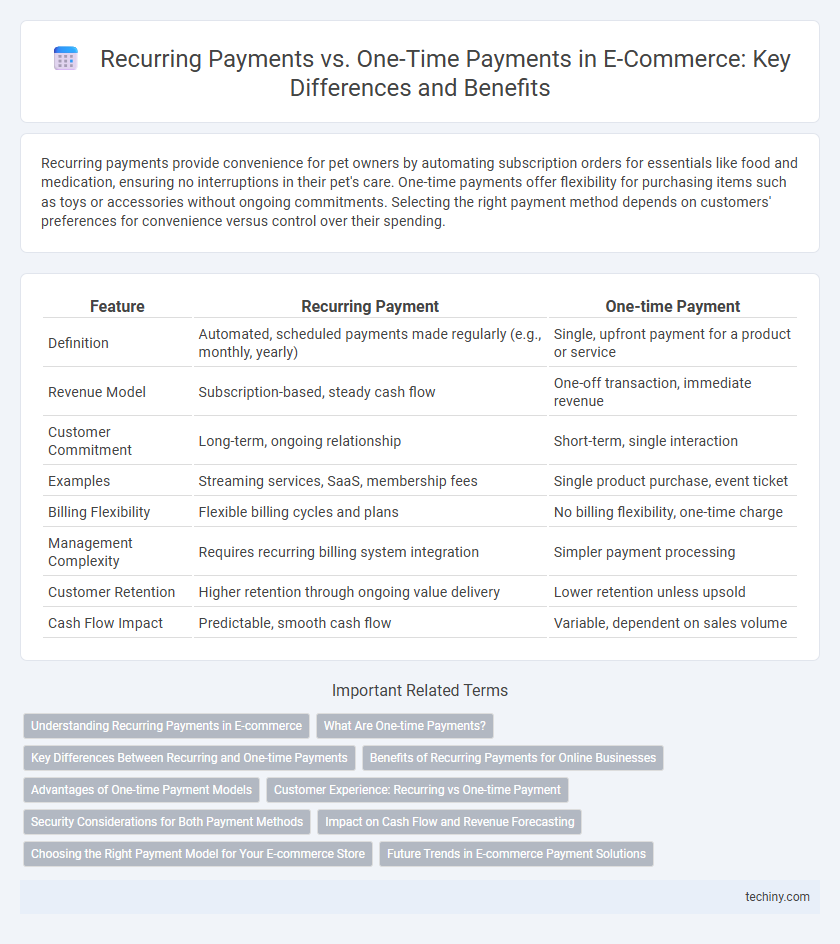Recurring payments provide convenience for pet owners by automating subscription orders for essentials like food and medication, ensuring no interruptions in their pet's care. One-time payments offer flexibility for purchasing items such as toys or accessories without ongoing commitments. Selecting the right payment method depends on customers' preferences for convenience versus control over their spending.
Table of Comparison
| Feature | Recurring Payment | One-time Payment |
|---|---|---|
| Definition | Automated, scheduled payments made regularly (e.g., monthly, yearly) | Single, upfront payment for a product or service |
| Revenue Model | Subscription-based, steady cash flow | One-off transaction, immediate revenue |
| Customer Commitment | Long-term, ongoing relationship | Short-term, single interaction |
| Examples | Streaming services, SaaS, membership fees | Single product purchase, event ticket |
| Billing Flexibility | Flexible billing cycles and plans | No billing flexibility, one-time charge |
| Management Complexity | Requires recurring billing system integration | Simpler payment processing |
| Customer Retention | Higher retention through ongoing value delivery | Lower retention unless upsold |
| Cash Flow Impact | Predictable, smooth cash flow | Variable, dependent on sales volume |
Understanding Recurring Payments in E-commerce
Recurring payments in e-commerce enable merchants to automatically charge customers at regular intervals, enhancing customer retention and predictable revenue streams. This payment model is ideal for subscription services, memberships, and consumable products, ensuring convenience and seamless transactions for both businesses and consumers. Implementing secure and flexible recurring billing systems is crucial for maintaining customer trust and reducing churn rates.
What Are One-time Payments?
One-time payments in e-commerce refer to single transactions where customers purchase products or services with a one-off charge. These payments are completed instantly, providing immediate access or delivery without recurring billing. One-time payments offer simplicity for both merchants and buyers, eliminating long-term commitments and subscription management.
Key Differences Between Recurring and One-time Payments
Recurring payments involve automatic, scheduled charges to a customer's account at regular intervals, ideal for subscription services or ongoing access to products. One-time payments require a single transaction to complete a purchase, commonly used for individual goods or services without future billing. Key differences include payment frequency, customer commitment level, and revenue predictability, with recurring payments fostering steady cash flow and customer retention compared to the immediate but finite nature of one-time payments.
Benefits of Recurring Payments for Online Businesses
Recurring payments provide online businesses with predictable revenue streams, enhancing cash flow stability and financial planning accuracy. They improve customer retention by simplifying the purchasing process and fostering long-term relationships through automated billing cycles. These benefits reduce administrative costs and increase lifetime customer value, driving sustainable business growth in the competitive e-commerce market.
Advantages of One-time Payment Models
One-time payment models in e-commerce offer clear budgeting benefits by providing customers with full ownership of products immediately, avoiding future billing complexities. This payment structure enhances cash flow predictability for businesses by securing revenue upfront without dependence on subscriber retention. One-time payments also reduce administrative overhead related to managing subscription cancellations, payment failures, and recurring billing disputes.
Customer Experience: Recurring vs One-time Payment
Recurring payments enhance customer experience by providing convenience, eliminating the need for repeated transactions, and ensuring uninterrupted access to products or services. One-time payments offer simplicity for single purchases but require manual action for each transaction, potentially causing delays or service interruptions. Businesses leveraging recurring payments often benefit from increased customer retention and predictable revenue streams.
Security Considerations for Both Payment Methods
Recurring payments often implement tokenization and encryption to securely store customer payment information, reducing the risk of data breaches during repeated transactions. One-time payments focus on strong authentication protocols like 3D Secure to verify each transaction, minimizing fraud potential in isolated purchases. Both methods require compliance with PCI DSS standards to ensure secure handling and transmission of sensitive payment data.
Impact on Cash Flow and Revenue Forecasting
Recurring payments provide predictable cash flow and enhance revenue forecasting accuracy by ensuring consistent income over time, reducing the risk of revenue fluctuations. One-time payments generate immediate cash influx but create variability in revenue streams, making long-term forecasting and budgeting more challenging. E-commerce businesses benefit from recurring payment models by stabilizing financial planning and improving customer lifetime value predictions.
Choosing the Right Payment Model for Your E-commerce Store
Choosing the right payment model for your e-commerce store depends on your product type and customer purchasing behavior. Recurring payments suit subscription-based services or products with regular delivery, ensuring steady revenue and improved customer retention. One-time payments work best for single-purchase items, offering simplicity and immediate revenue without long-term commitment.
Future Trends in E-commerce Payment Solutions
Recurring payments are becoming increasingly dominant in e-commerce due to the growing subscription economy and consumer preference for convenience. Advanced technologies such as AI-driven fraud detection and blockchain are enhancing the security and efficiency of both recurring and one-time payment systems. Future trends indicate seamless integration of multi-currency support and digital wallets, driving greater global adoption and personalized payment experiences.
Recurring Payment vs One-time Payment Infographic

 techiny.com
techiny.com